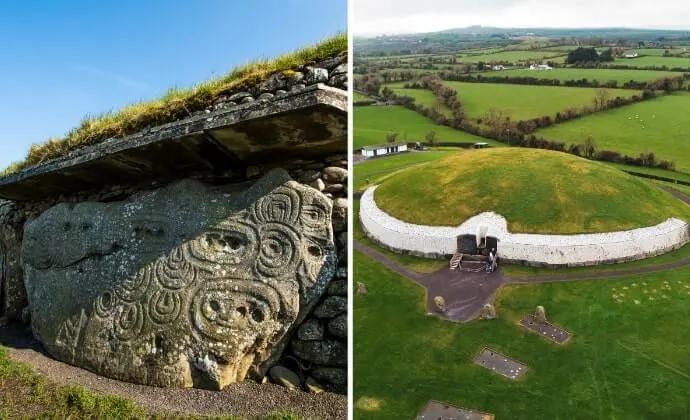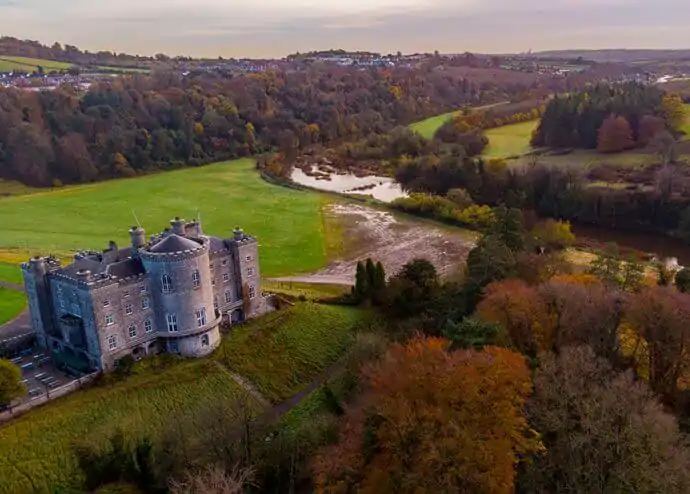Knowth is one of 3 ancient monuments located at Brú na Bóinne in Meath and it’s one of the main stops on the Boyne Valley Drive.
The other two, of course, are Newgrange and Dowth (although you can visit Dowth without going through Brú na Bóinne).
In the guide below, you’ll find info on everything from what Knowth was used for and the history of the area to what you’ll get to see when you visit.
Some quick need-to-knows about Knowth

Photos via Shutterstock
Although a visit to Knowth is fairly straightforward, there are a few need-to-knows that’ll make your visit that bit more enjoyable.
1. Location
Knowth is situated on the banks of the River Boyne and it’s accessed via the Brú na Bóinne visitor centre. It’s a 15-minute drive from Drogheda, a 20-minute drive from Navan and a 35-minute drive from Dublin Airport.
2. Ticket costs
The prices for Brú na Bóinne vary massively:
- Brú na Bóinne Tour + Newgrange Chamber: Adult: €18, Senior: €16, Child/Student: €12, Family: €48
- Newgrange Tour + Exhibition: Adult: €10, Senior: €8, Child/Student: €5, Family: €25
- Knowth Tour + Exhibition: Adult: €10, Senior: €8, Child/Student: €5, Family: €25
- Visitor Centre Exhibition Only: Adult: €5, Senior: €4, Child/Student: €3, Family: €13
3. Opening times
The visitor centre atBrú na Bóinne is open:
- January, October, November, December: 9:00 – 16:15
- February, March, April: 9:30 – 16:45
- May, June, July, August: 9:00 – 17:45
- September: 9:00 – 17:15
4. Make sure you book in advance
I’d strongly recommend that you book your ticket for Knowth before arriving at Brú na Bóinne. This is one of the most popular places to visit in Meath, so don’t rely on tickets being available at the visitor centre.
The History of Knowth

Photos via Shutterstock
Knowth dates back to 3,200 BC which makes it older than both Stonehenge and the pyramids of Giza. During the late Neolithic and the Bronze Age, Knowth was used for rituals and ceremonies.
Many offerings were found near the entrance to the eastern passage at Knowth, in the immediate surrounding of a grooved timber circle. After this period, the site was not used for 2,000 years as its mound covered over both entrances.
Late Iron Age and Early Christian Period
In the late Iron Age and the early Christian Period, Knowth became a hill fort and, for the first time in history, people started to live at this site.
Two ditches were dug; one on the top of the mound and one on the bottom and, over the years, Knowth became the capital of the Kingdom of Northern Brega.
Middle Ages and modern period
Some evidence suggests that the Normans used this site as a motte during the 12th century, however, Knowth soon became the property of a group of Cistercian monks. During this period several stone buildings were built on top of the hill and the mound was used as a farm.
Finally, in 1939, the site was taken over by the state. Minor excavations took place in 1941, however, only in 1962 did full-scale excavations begin and both entrances to Knowth were discovered soon after.
Things to see and do at Knowth

One of the reasons that a visit to Knowth is so popular is due to the sheer volume of history there is to be discovered. Below, you’ll find some of the features of the site to look out for.
1. The 5,000 year-old mound
The mound of Knowth was built in approximately the same period as Newgrange and Dowth – around 3,200 BC. This large mound, known as ‘Site 1’, covers half a hectare and measures 311 feet (95 metres) at its widest point. Eighteen smaller mounds are situated all around it. Inside Site 1 two passages leading to different chambers were also found.
2. The chambers
Even though the two chambers in Knowth are only three meters apart from each other, they are not connected by any passage. The eastern tomb consists of a 130-foot (40-meters) passage leading to a main cruciform chamber that has three side recesses and a beehive-shaped roof.
The western tomb was originally 115 feet (35 meters) in length. The passage leading to the chamber is incredibly narrow and, in some parts, it’s only 1.3 feet (40 centimetres) wide.
3. The ancient decorated stones
At Knowth you will also find the biggest collection of megalithic art from the Neolithic period in the whole of Western Europe (often confused with Celtic symbols). Almost all of the kerbstones surrounding the main mound are characterised by carvings, most of which are representations of astronomical motifs, such as the moon or the sun.
Here you will also find the oldest representation of the moon in history. It’s likely that this site was originally built so that both the sun and the moon would illuminate the two main passages during the equinoxes.
However, the structure has been modified through the years and nowadays the alignment no longer takes place. Other popular motifs present on the kerbstones are lozenges and spirals.
4. The 127 kerbstones
There are 127 kerbstones surrounding the main mound at Knowth. Three of them are missing and four of them are badly damaged. These stones are composed of a type of argillaceous sandstone named ‘Greywacke’ that can be easily carved, which made it perfect for megalithic art.
These stones come from Clogherhead, about 12.5 miles (20 kilometres) away from Knowth. It is still unclear how these kerbstones were transported here but many scholars believe that they were carried to this site by sledge.
Things to do nearby
One of the beauties of Knowth is that it’s a short spin away from many of the best places to visit in Meath.
Below, you’ll find a handful of things to see and do a stone’s throw from Knowth.
1. Newgrange and Dowth

Photos via Shutterstock
Newgrange was built around the same period of Knowth and consists of a large mound which contains a long passage leading to the main chamber. Inside the chamber, human remains were found. Unlike Knowth, Newgrange is still perfectly aligned with the winter solstice. The site of Dowth is also worth visiting. Unlike the two other sites, here you won’t need a ticket to enter.
2. Old Mellifont Abbey (15-minute drive)

Photos via Shutterstock
The first Cistercian monastery of Ireland, Old Mellifont Abbey was built in 1142 by a group of French monks. After the Dissolution of the Monasteries, in 1536, this structure stopped functioning as a monastery. However, this abbey remained an important political point. In 1603, the treaty that put an end to the Nine Year War was signed within its walls and William of Orange adopted it as his headquarters during the Battle of the Boyne.
3. Slane Castle

Photo by Adam.Bialek (Shutterstock)
Slane Castle is well worth a visit. Aside from its rich history and its tenure as one of Ireland’s leading concert venues, Slane Castle is also home to one of our favourite whiskey distilleries in Ireland. When you’ve finished up, you can ramble through Slane village or head up to see the Hill of Slane.
